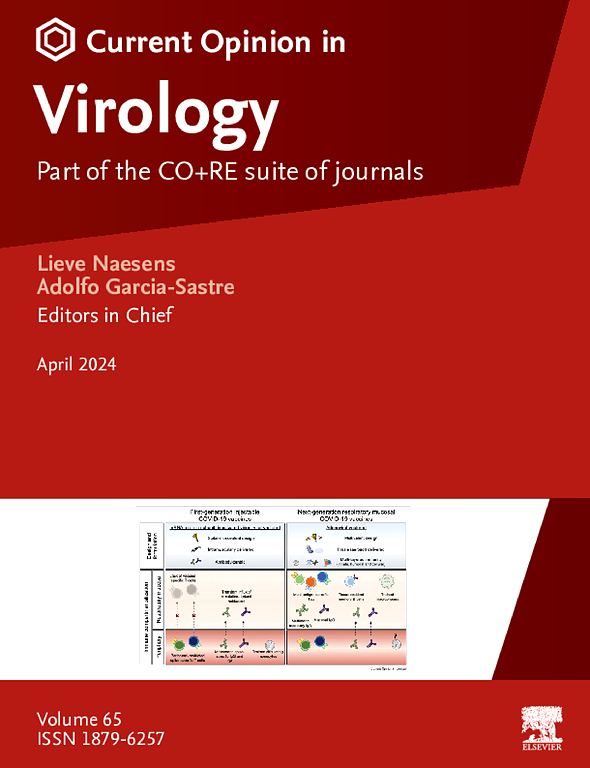Intracranial calcifications in congenital viral infections: mechanisms and cellular roles
IF 5.1
2区 医学
Q1 VIROLOGY
引用次数: 0
Abstract
Intracranial calcifications (ICCs) are a characteristic neuropathological feature of several congenital viral infections, including Zika virus (ZIKV), cytomegalovirus (CMV), and lymphocytic choriomeningitis virus (LCMV). These lesions are linked to severe neurodevelopmental outcomes, such as microcephaly, epilepsy, and cognitive deficits, yet the mechanisms underlying their formation and resolution remain unclear. ICCs are thought to arise from an imbalance in osteogenic and osteolytic signaling in the developing brain. Recent work implicates pericytes as key targets of ZIKV, capable of osteogenic reprogramming and direct mineral deposition. However, the pathways leading to calcification in CMV and LCMV infections are less well understood. Microglia, the brain’s resident immune cells, have emerged as potential regulators of calcification. While microglia can limit mineral deposition in noninfectious models of neurodegeneration and injury, their role in the context of congenital viral infection remains speculative. Whether they act to contain calcification, participate in its resolution, or contribute to pathogenesis via neuroinflammatory signaling is still unknown. This short review summarizes current knowledge of ICC pathogenesis during congenital ZIKV, CMV, and LCMV infections, with a focus on emerging potential cellular mediators, such as pericytes and microglia. We discuss known mechanisms, gaps in knowledge, and opportunities to build more representative animal models to elucidate how different viral infections orchestrate calcification in the fetal brain. Clarifying these pathways may inform future therapeutic approaches to mitigate virus-induced neurodevelopmental disorders.
先天性病毒感染的颅内钙化:机制和细胞作用
颅内钙化(ICCs)是几种先天性病毒感染的特征性神经病理特征,包括寨卡病毒(ZIKV)、巨细胞病毒(CMV)和淋巴细胞性脉络丛脑膜炎病毒(LCMV)。这些病变与严重的神经发育结果有关,如小头畸形、癫痫和认知缺陷,但其形成和消退的机制尚不清楚。ICCs被认为是由发育中的大脑中成骨和溶骨信号的不平衡引起的。最近的研究表明,周细胞是ZIKV的关键靶点,具有成骨重编程和直接矿物沉积的能力。然而,CMV和LCMV感染导致钙化的途径尚不清楚。小胶质细胞,大脑的常驻免疫细胞,已经成为钙化的潜在调节者。虽然小胶质细胞可以限制非感染性神经变性和损伤模型中的矿物质沉积,但它们在先天性病毒感染中的作用仍是推测性的。它们是抑制钙化、参与钙化的解决,还是通过神经炎症信号参与钙化的发病机制尚不清楚。这篇简短的综述总结了目前对先天性ZIKV、巨细胞病毒和LCMV感染中ICC发病机制的了解,重点是新出现的潜在细胞介质,如周细胞和小胶质细胞。我们讨论了已知的机制,知识上的差距,以及建立更有代表性的动物模型来阐明不同病毒感染如何协调胎儿大脑钙化的机会。阐明这些途径可能为未来的治疗方法提供信息,以减轻病毒诱导的神经发育障碍。
本文章由计算机程序翻译,如有差异,请以英文原文为准。
求助全文
约1分钟内获得全文
求助全文
来源期刊

Current opinion in virology
VIROLOGY-
CiteScore
11.80
自引率
5.10%
发文量
76
审稿时长
83 days
期刊介绍:
Current Opinion in Virology (COVIRO) is a systematic review journal that aims to provide specialists with a unique and educational platform to keep up to date with the expanding volume of information published in the field of virology. It publishes 6 issues per year covering the following 11 sections, each of which is reviewed once a year: Emerging viruses: interspecies transmission; Viral immunology; Viral pathogenesis; Preventive and therapeutic vaccines; Antiviral strategies; Virus structure and expression; Animal models for viral diseases; Engineering for viral resistance; Viruses and cancer; Virus vector interactions. There is also a section that changes every year to reflect hot topics in the field.
 求助内容:
求助内容: 应助结果提醒方式:
应助结果提醒方式:


